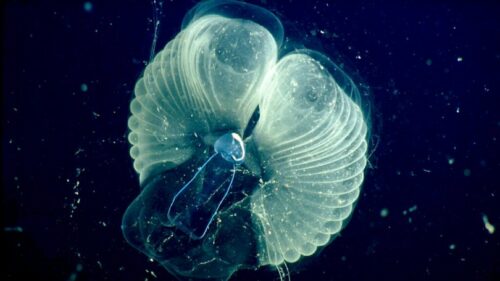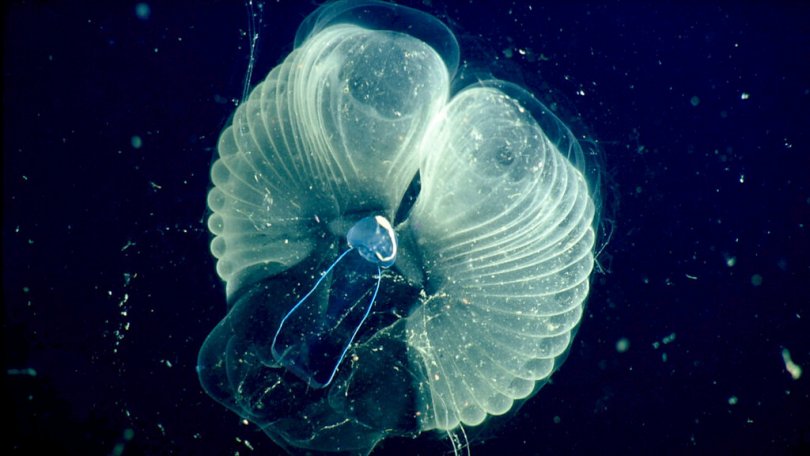I do not usually give the “Chill” (children’s) section of the Sunday Mail newspaper more than a cursory glance but the section in the 14th June issue was all about snot.
Not that it is my favourite topic, but did you know the difference between snot and broccoli? Well, kids do not like to eat broccoli. This was one of the Jokes of the Week (by kids I presume). I don’t know if there was meant to be a theme here, but another joke was, “What did one boogey say to the other boogey? Answer: You think you’re funny, but you’re snot.” Another joke was, “Did you know that if your nose runs and your feet smell, you’re built upside down!” These were three of the four jokes published that day.
But I only noticed these jokes after seeing that the main feature of the “Chill” section that day was about “Sea Creatures That Build Snot Palaces”. It was mainly the photos that caught my eye though. Several photos seemed to feature large jellyfish. It turns out that they were actually tiny tadpole-like, deep water sea creatures called, of all things, giant larvaceans (Bathochordaeus). They are said to build “snot palaces”, the equivalent of complex five-storey homes.
The kids’ jokes on the opposite page may just have been coincidental. The article about the snot palaces of the giant larvaceans was written by Seth Borenstein, an AP Science Writer. Seth started with the comment, “Tiny sea creatures make the moist amazing houses out of snot.” Not the kind of thing to get excited about, but I wanted to know just what kind of creatures these were, so I read on.
The article explained that scientists are close to solving the mystery of how giant larvaceans build delicate mucus (or mucous) structures for protection from predators. They apparently produce these “snot palaces” with snot coming from their head. The ‘palaces’ also funnel and filter food for the larvaceans. The palaces become clogged though, so the larvaceans need to build a new ‘palace’ every day or so.
A research team from the Monterey Bay Aquarium Research Institute has been studying the larvaceans and their results were published in the journal “Nature”. The larvaceans seem to live in depths of 200-400m off of Monterey Bay.
Researchers haven’t been able to take the delicate “snot palaces’ into the laboratory to study them, so they used a remote submarine (ROV), cameras and lasers to watch the creatures in deep waters. They used 3D laser scan technology to ‘enter’ the inner chambers of the palaces, the they recreated them with software to model the structure.
The biggest larvaceans are said to be about 10cm. Their palaces can be ten times their own size, so 1m palaces are commonplace. They are often almost transparent, and they flow all around the larvacean.
The palaces are created by the larvaceans secreting mucus from cells on the top of their heads and “then expand those much like a balloon into the structures”. This process takes about one hour. Water can flow through the structure making it difficult for predatory fish to sense.
Scientists hope that their studies will help NASA engineers to build expanding homes on the moon, or other planets such as Mars.
Similar details from the Mercury News can be found at https://www.mercurynews.com/2020/06/03/every-day-they-build-five-story-snot-palaces-near-monterey-bay/.
This photo is taken from that web page: –

YouTube videos can be found at both https://www.youtube.com/watch?v=L1wFb_ShW7k and https://www.youtube.com/watch?v=ECd9KQPrJoA.
According to https://www.youtube.com/watch?v=L1wFb_ShW7k, “Monterey Bay Aquarium Research Institute (MBARI) – Bathochordaeus is considered a giant among larvaceans. The giant larvacean’s claim to fame is the huge mucous house it builds. The house is made up of two filters and basically functions as an elaborate feeding apparatus. They eat tiny particles of dead or drifting plants and animals that float through the water column. The outer filter traps larger particles too big for the animal to eat, while the inner filter guides smaller food particles into the larvacean’s mouth. Eventually the filters get clogged and the larvacean abandons them. The sinking houses, packed with food particles, provide an important source of food for animals living on the seafloor. Researchers at the Monterey Bay Aquarium Research Institute (MBARI) are using remotely operated vehicles, video cameras, and lasers to study giant larvaceans right in their own habitat. We just described a new species of giant larvacean, Bathochordaeus mcnutti, making a total of three species of giant larvacean now found in Monterey Bay, California.”
One comment on the post was,”… they’re essentially larval tunicates (sea squirts) that never grow up ….”
More details about the study of by the Monterey Bay Aquarium Research Institute can be found at both https://www.mbari.org/taking-a-closer-look-leads-to-discovery-of-a-prevalent-deep-sea-animal/ and https://advances.sciencemag.org/content/3/8/e1700715.full.

